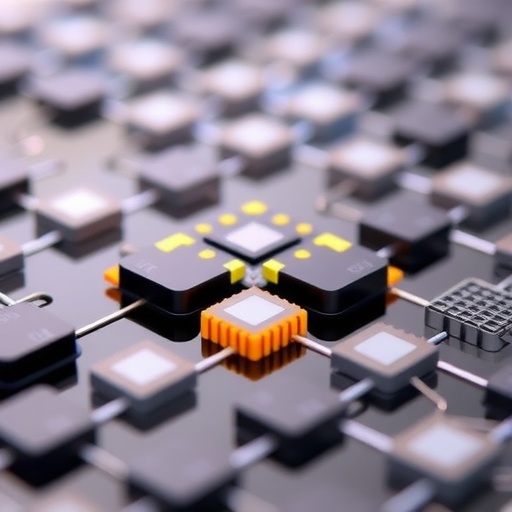A groundbreaking development has emerged from the laboratories of Seoul National University, where researchers have formulated a comprehensive manufacturing blueprint for stretchable synaptic transistors. This innovative review meticulously integrates the critical components of material selection, fabrication process flows, and device architecture, offering unprecedented insights into achieving electro-mechanical stability alongside precise learning capabilities in soft electronic systems. Such advancements are poised to revolutionize wearable technologies, influencing the future of flexible neuromorphic hardware and bio-interactive applications.
At the heart of this review lies a novel, process-centric methodology that contrasts a range of fabrication techniques—namely photopatterning, printing, and lamination-and-transfer—evaluated across diverse substrates, electrodes, semiconductors, and ion-conducting dielectrics. Tingyu Long, the pioneering first author of this study, emphasizes that maintaining stable electrical performance under extreme mechanical deformation, specifically greater than 50% to 100% tensile strain at low operational voltages, is paramount for the reliable deployment of these devices. This holistic comparative approach marks a significant departure from prior fragmented efforts, making it an indispensable reference in the field of stretchable electronics.
One of the most notable insights elucidated in the review is the fundamental importance of device architecture. Vertical organic electrochemical transistors (OECTs) demonstrate superior performance metrics by shortening charge transport pathways and effectively decoupling in-plane mechanical damage from current conduction. This architectural design mitigates the deleterious effects of cracking common in planar electronic channels when subjected to mechanical stress. The vertical configuration also facilitates enhanced operational stability during repetitive mechanical deformation, a critical attribute for wearable and implantable electronic devices.
Complementing architectural innovations, the study explores mechanical design strategies that leverage wavy, corrugated, or textile-like constructs. These configurations distribute and dissipate mechanical strain across composite fiber networks, preventing localized stress concentrations that often culminate in functional degradation. Such mechanics enable synaptic transistors to exhibit persistent synaptic plasticity mechanisms, essential for emulating biological neural systems even under the rigors of continuous biomechanical movements, such as those encountered in skin-mounted electronics.
The implications of these technological breakthroughs extend well beyond fundamental science. For instance, the review outlines immediate applications in on-body artificial intelligence (AI) systems capable of real-time biosignal filtering akin to electrocardiogram (ECG) processing. This capability elevates the potential for advanced health monitoring platforms that seamlessly integrate with human physiology. Further, the design principles laid out promise safer human-robot interactions via nociceptive electronic skin, which perceives potentially damaging stimuli and modulates responses accordingly, offering bio-mimetic feedback systems for prosthetics and wearable robotics.
Significantly, the integration of artificial afferent and efferent neural interfaces within these stretchable platforms holds transformative potential. These interfaces can transduce sensory inputs to motor commands with ultralow energy consumption, ensuring operational compatibility with soft tissue mechanics. This bioinspired approach embodies a convergence of neuroscience, materials science, and electrical engineering, charting a path toward next-generation prosthetic devices and neuroelectronics that communicate seamlessly with the human nervous system.
Despite these encouraging advancements, the review does not shy away from highlighting formidable challenges that remain to be resolved. Chief among these is the development of n-type and ambipolar stretchable semiconductors that sustain mixed ionic and electronic conduction without compromising mechanical robustness. Equally pivotal is the engineering of photo-crosslinkable and printable materials beyond traditional polymeric channels, encompassing electrolytes and small-molecule semiconductors, which are essential for scalable and versatile device fabrication.
The authors also underscore the necessity for advanced interfacial insulation techniques that enable vertical stacking in device architectures without inducing thermal damage—an essential consideration for maintaining device integrity during multi-layer fabrication processes. Additionally, creating biocompatible, self-healing, and self-powered platform technologies remains a critical frontier to ensure long-term implantable electronics can function reliably inside biologically dynamic environments without invoking immune responses or requiring frequent maintenance.
The integration of these stretchable synaptic transistors within large-area arrays, compatible with complementary metal-oxide-semiconductor (CMOS) technology, will ultimately enable scalable manufacturing paradigms suitable for commercial wearable and implantable devices. The seamless interface with traditional microfabrication techniques bridges the prevailing gap between flexible material properties and next-generation electronics manufacturing, paving the way toward ubiquitous neuromorphic systems embedded directly on the human body.
Through this review, Seoul National University’s team highlights that the future of soft neuromorphic hardware is not merely a pursuit of novel materials but equally an architectural and process engineering challenge. By adopting a system-wide perspective, this work offers a roadmap that redefines the parameters for designing flexible synaptic devices capable of functioning in biomimetic environments where mechanical strain and electrical performance coalesce.
Finally, the interdisciplinary collaboration reflected in this study—merging expertise from materials chemistry, electrical engineering, and applied mechanics—demonstrates the vitality of convergent science in addressing complex challenges intrinsic to the next wave of wearable electronic devices. The combined progress in stretchable transistor technology signals a new paradigm where electronics are no longer rigid tools but dynamic extensions of biological systems capable of adaptive learning and interaction.
Subject of Research: Not applicable
Article Title: Manufacturing strategies for stretchable synaptic transistors
Web References: DOI link
Image Credits: Tingyu Long, et al.
Keywords: Chemistry, Materials Science, Particle Physics, Nanotechnology, Polymer Chemistry, Superconductors
Tags: bio-interactive applicationscomprehensive manufacturing blueprint for electronicsdevice architecture in electronicselectro-mechanical stabilityflexible neuromorphic hardwareinnovative manufacturing techniquesphotopatterning fabrication methodsprinting and lamination techniquesstable electrical performance under strainstretchable synaptic transistorsvertical organic electrochemical transistorswearable technologies





